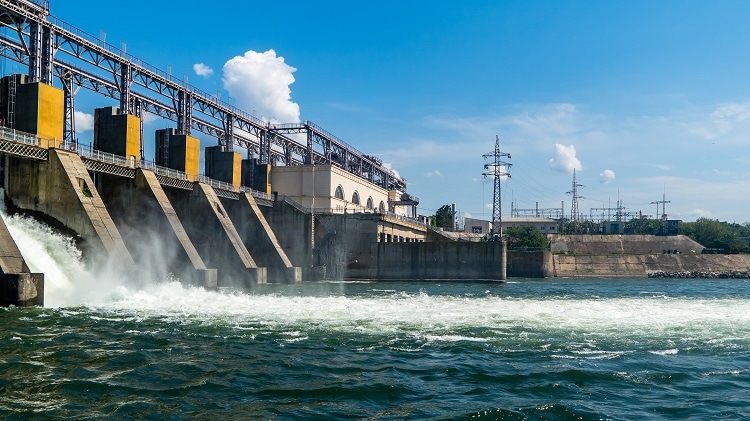
6.9 Hydroelectric Power
2 min read•january 8, 2023
Karla Jauregui Sandoval
Karla Jauregui Sandoval
is energy that comes from a turbine that produces energy from the movement of bodies of water.
There are two ways to generate hydroelectric power: and tidal waves.
Image Courtesy of AZoM

How it works
are built on rivers where the terrain will produce an artificial lake or reservoir.
As the water is released from the reservoir, it flows through a pipe and falls to a lower elevation, which generates . This is used to turn a turbine, which generates . The is then sent to a , where it is converted into an that can be used to power homes, businesses, and other buildings.
Benefits and Drawbacks
Benefits 👍🏻 | Drawbacks 👎🏻 |
|
|
Important Dams to Know
Hoover Dam ➱ provides , water and for industrial and domestic use as well as hydroelectric power
Grand Coulee ➱ Largest producer in the USA
Three Gorges Dam ➱ Controls flood and provides power. Causing landslides and erosion of reservoirs downstream
Watch: Environmental Science
Key Terms to Review (13)
Dams
: Dams are structures built across rivers or streams to control the flow of water and create reservoirs. They are used for various purposes such as flood control, irrigation, hydroelectric power generation, and water supply.Ecosystem Destruction
: Ecosystem destruction refers to the significant and irreversible damage caused to a natural habitat or ecosystem due to human activities such as deforestation, pollution, or urbanization. It disrupts the delicate balance of species interactions and can lead to the loss of biodiversity.Electrical Current
: Electrical current refers to the flow of electric charge in a circuit. It is the movement of electrons through a conductor, such as a wire.Electricity
: Electricity is a form of energy resulting from the movement of charged particles, such as electrons. It powers various devices and systems in our daily lives.Fish Migration Patterns
: Fish migration patterns refer to the regular movements of fish between different habitats for feeding, breeding, or other purposes. These patterns are often influenced by factors like temperature changes, availability of food sources, and reproductive needs.Flood Control
: Flood control involves managing or preventing floods by implementing various strategies and structures. These strategies aim to reduce flood damage by controlling water levels, redirecting water flow, or storing excess water during heavy rainfall events.Generator
: A generator is a device that converts mechanical energy into electrical energy. It typically consists of coils rotating within a magnetic field, producing an alternating current (AC).Human Displacement
: Human displacement refers to the forced movement of people from their homes or communities due to various factors such as conflicts, natural disasters, or development projects. It often results in individuals and families being uprooted and having to seek refuge elsewhere.Hydropower
: Hydropower refers to the generation of electricity using the force of moving water, such as rivers or waterfalls. It harnesses the kinetic energy of flowing water to turn turbines and generate electricity.Irrigation
: Irrigation is the process of supplying water to crops or plants in order to help them grow. It involves diverting water from a source, such as a river or well, and distributing it to fields through channels or pipes.Kinetic Energy
: Kinetic energy refers to the energy possessed by an object due to its motion. It is dependent on both the mass and velocity of the object.Renewable Source
: A renewable source refers to an energy resource that can be replenished naturally and sustainably over time. These sources are not depleted when used and have minimal negative impact on the environment.Sedimentation
: Sedimentation is the process by which particles settle out of a fluid (such as water) and accumulate at the bottom over time. It occurs when suspended particles become too heavy to remain in suspension and sink down due to gravity.6.9 Hydroelectric Power
2 min read•january 8, 2023
Karla Jauregui Sandoval
Karla Jauregui Sandoval
is energy that comes from a turbine that produces energy from the movement of bodies of water.
There are two ways to generate hydroelectric power: and tidal waves.
Image Courtesy of AZoM

How it works
are built on rivers where the terrain will produce an artificial lake or reservoir.
As the water is released from the reservoir, it flows through a pipe and falls to a lower elevation, which generates . This is used to turn a turbine, which generates . The is then sent to a , where it is converted into an that can be used to power homes, businesses, and other buildings.
Benefits and Drawbacks
Benefits 👍🏻 | Drawbacks 👎🏻 |
|
|
Important Dams to Know
Hoover Dam ➱ provides , water and for industrial and domestic use as well as hydroelectric power
Grand Coulee ➱ Largest producer in the USA
Three Gorges Dam ➱ Controls flood and provides power. Causing landslides and erosion of reservoirs downstream
Watch: Environmental Science
Key Terms to Review (13)
Dams
: Dams are structures built across rivers or streams to control the flow of water and create reservoirs. They are used for various purposes such as flood control, irrigation, hydroelectric power generation, and water supply.Ecosystem Destruction
: Ecosystem destruction refers to the significant and irreversible damage caused to a natural habitat or ecosystem due to human activities such as deforestation, pollution, or urbanization. It disrupts the delicate balance of species interactions and can lead to the loss of biodiversity.Electrical Current
: Electrical current refers to the flow of electric charge in a circuit. It is the movement of electrons through a conductor, such as a wire.Electricity
: Electricity is a form of energy resulting from the movement of charged particles, such as electrons. It powers various devices and systems in our daily lives.Fish Migration Patterns
: Fish migration patterns refer to the regular movements of fish between different habitats for feeding, breeding, or other purposes. These patterns are often influenced by factors like temperature changes, availability of food sources, and reproductive needs.Flood Control
: Flood control involves managing or preventing floods by implementing various strategies and structures. These strategies aim to reduce flood damage by controlling water levels, redirecting water flow, or storing excess water during heavy rainfall events.Generator
: A generator is a device that converts mechanical energy into electrical energy. It typically consists of coils rotating within a magnetic field, producing an alternating current (AC).Human Displacement
: Human displacement refers to the forced movement of people from their homes or communities due to various factors such as conflicts, natural disasters, or development projects. It often results in individuals and families being uprooted and having to seek refuge elsewhere.Hydropower
: Hydropower refers to the generation of electricity using the force of moving water, such as rivers or waterfalls. It harnesses the kinetic energy of flowing water to turn turbines and generate electricity.Irrigation
: Irrigation is the process of supplying water to crops or plants in order to help them grow. It involves diverting water from a source, such as a river or well, and distributing it to fields through channels or pipes.Kinetic Energy
: Kinetic energy refers to the energy possessed by an object due to its motion. It is dependent on both the mass and velocity of the object.Renewable Source
: A renewable source refers to an energy resource that can be replenished naturally and sustainably over time. These sources are not depleted when used and have minimal negative impact on the environment.Sedimentation
: Sedimentation is the process by which particles settle out of a fluid (such as water) and accumulate at the bottom over time. It occurs when suspended particles become too heavy to remain in suspension and sink down due to gravity.
Resources
© 2024 Fiveable Inc. All rights reserved.
AP® and SAT® are trademarks registered by the College Board, which is not affiliated with, and does not endorse this website.